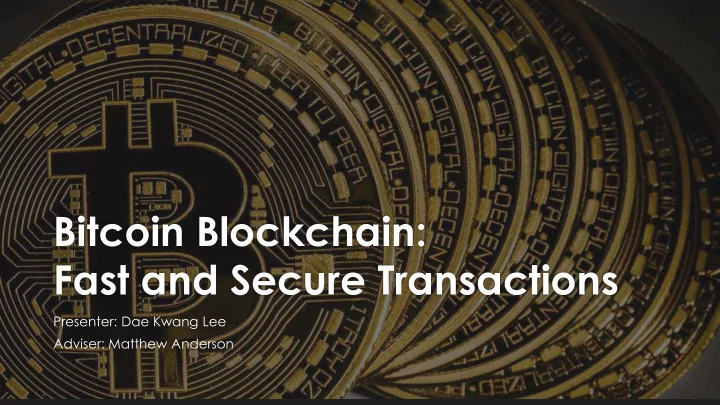

Bitcoin Blockchain: Fast and Secure Transactions Presenter: Dae Kwang Lee Adviser: Matthew Anderson
What is Bitcoin? B C Decentralized peer-to-peer electronic payment system A Each node stores a copy of the ▪ public transaction history D E Transactions verified by nodes ▪ Nodes send new transactions to ▪ their peers Peer network of node A
Transaction Block #1 Block #2 Input: previous output hash ▪ Proof of Work Proof of Work Output: instructions for sending ▪ Block #0’s hash Block #1’s hash bitcoins Transactions Transactions
Blockchain Block #1 Block #2 ▪ Miner • Collects transactions & generates a block by Proof of Work Proof of Work solving computational puzzle* Block #0’s hash Block #1’s hash • Sends block to peers • Mines a 1MB block / 10min • Incentivized with bitcoin Transactions Transactions and RESIDUALS *Proof Of Work Hash (previous block’s hash + • transactions + nonce) <= target
Blockchain Forking and Primitive Solution Forking happens when.. Duplicate blocks are generated • Each node has different history • Transactions are not validated! • ? May develop into selfish-mining to • revert transactions and double-spend NAKAMOTO CONSENSUS Stable Blocks Nodes agree on this policy • Resolves by adding block on the • longest chain
Is there a faster policy that generates less stale blocks? Nakamoto Consensus Adds block onto the longest chain ▪ $1 $2 $1.1 $0.5 $1 Greedy Heaviest Observed SubTree (GHOST) 2013 $2 $1 GHOST HIRES Adds block on the heaviest ▪ subtree at each fork $1 $1.5 $1.3 $0.7 Faster but generates more stale ▪ blocks $0.4 Highest Residual Selection Policy (HIRES) $1.1 $1.3 $1.6 $0.6 $2 $1.1 Adds block on the most expensive ▪ subtree at each fork
Bitcoin Simulator ▪ Arthur Gervais Collects block size data from Blockchain.Info from ▪ May 2015 to November 2015 16 threads of mining activities ▪ Can adjust block parameters ▪ Returns each node’s copy of the ledger ▪
Methods I. Collected txFee data to build probability distribution II. Used txFee probability distribution during mining III. Made miners to pick the highest residual for each mining activity IV. Optimized HR policy to go five level down Experiments: I. Typical parameters II. Extreme parameters III. Extreme parameters with selfish mining
Experiment I Left: HIRES Right: NAKAMOTO
Experiment II Left: HIRES Right: NAKAMOTO
Experiment III Left: HIRES Right: NAKAMOTO
Result Parameters Generating 100 1MB blocks within 6s and Generating 100 1MB blocks within 6s while distributing to 500 nodes selfish miner > 50% Nakamoto # Total blocks: 42.120 # Total blocks: 102.13 ▪ ▪ # Stale blocks: 28.094 (66.7%) # Stale blocks: 46.10 (45.1%) ▪ ▪ Mean Block Propagation Time: 87.073 ▪ Honest Mining Income = 55.46 ▪ Attacker Income = 54.92 (-0.009%) ▪ HIRES # Total blocks: 31.60 # Total blocks: 99.36 ▪ ▪ # Stale blocks: 12.1 (38.3%) # Stale blocks: 38.012 (38.2%) ▪ ▪ Mean Block Propagation Time: 128.02 ▪ Honest Mining Income = 59.30 ▪ Attacker Income = 55.206 (-6.9%) ▪
Experiment I ▪ Both policies generate 0 stale blocks • Conclusion: Experiment II ▪ ❖ HIRES: 1. HIRES is slower and generates less Less stale blocks • stale blocks Less blocks in total (timeout expired) • Greater block propagation time • 2. HIRES incentivizes attackers less than honest miners Experiment III ▪ 3. HIRES contradicts my hypothesis ❖ HIRES: based on the GHOST Less stale blocks • Attacker loses more money •
Future Work Optimize the new policy to propagate more blocks I. Fast propagation II. Micro payment III. Makes fewer stale blocks
THANK YOU
Recommend
More recommend